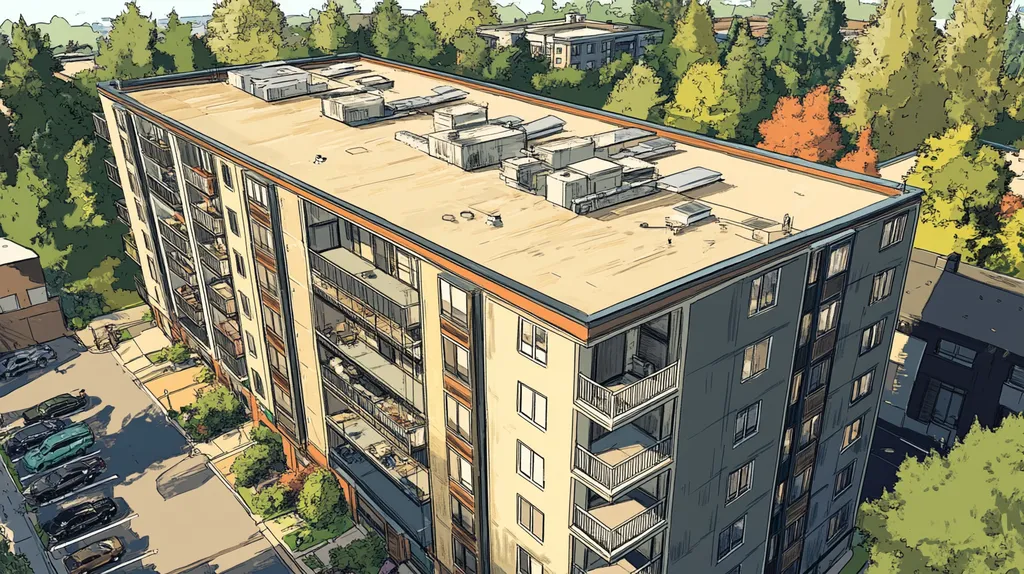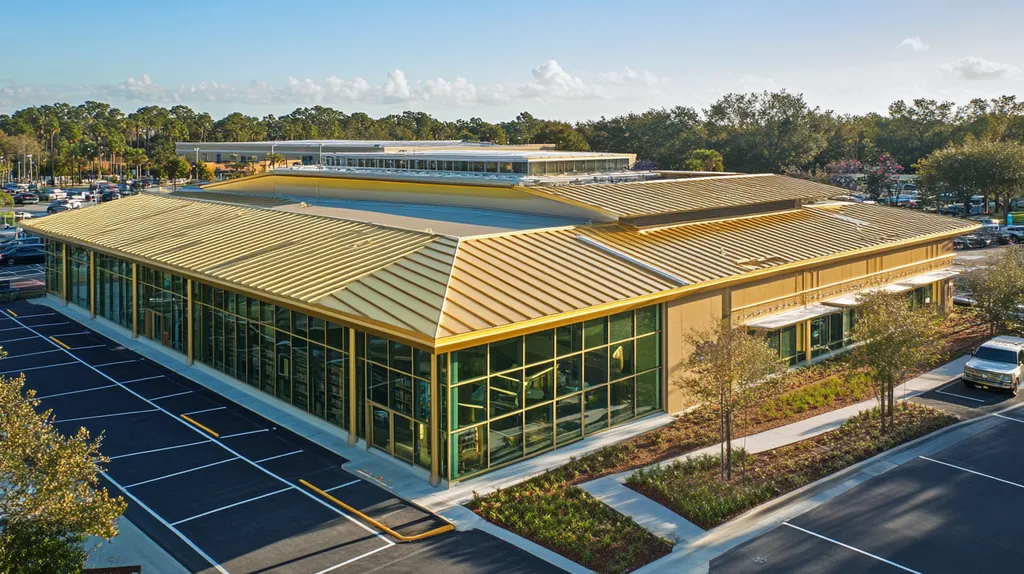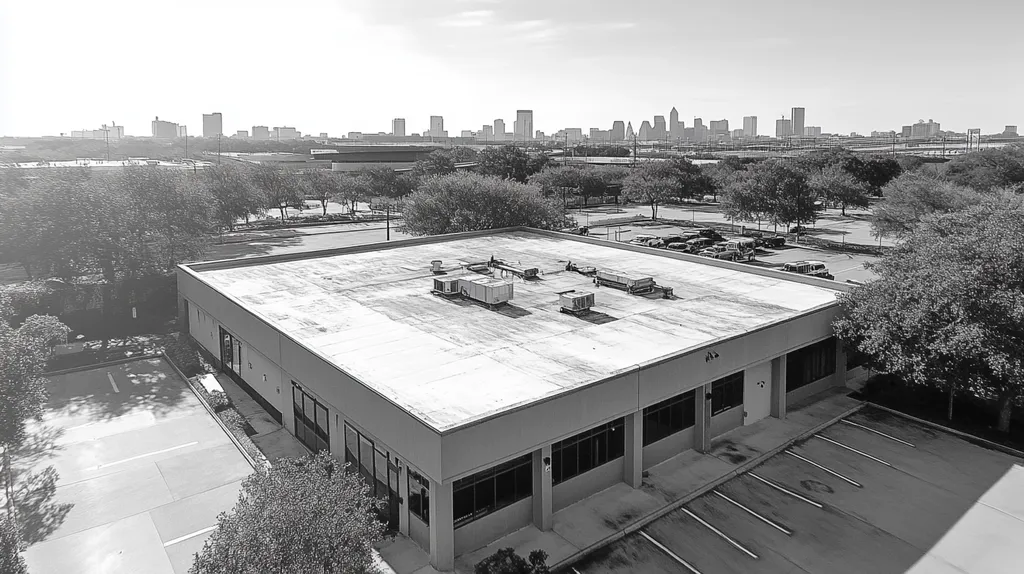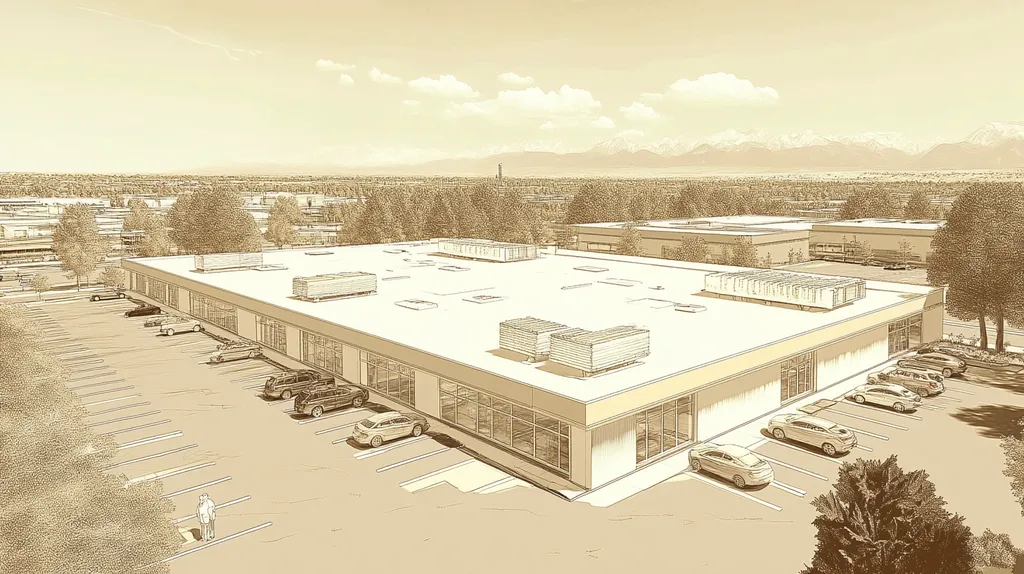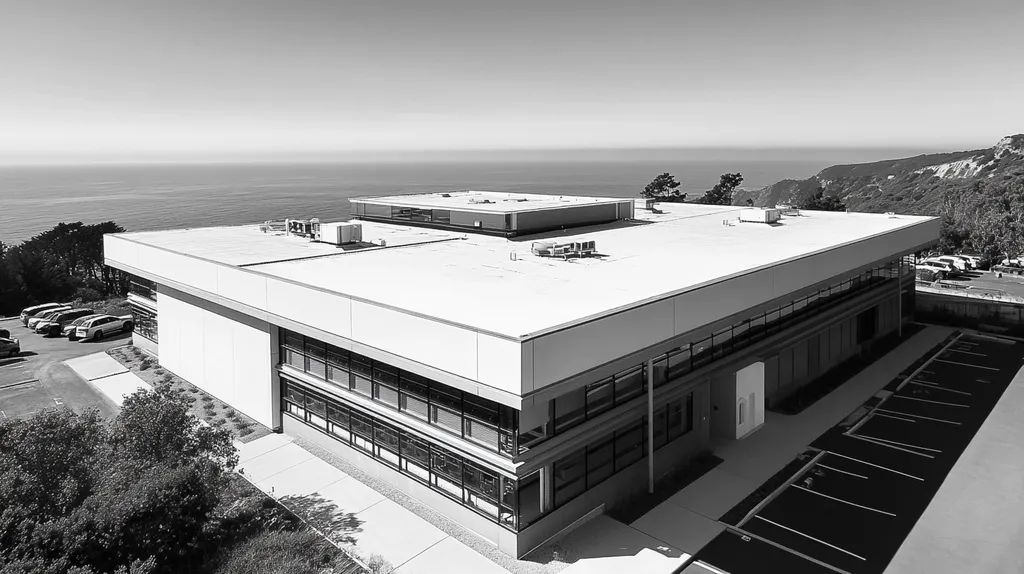In today’s industrial landscape, over 40% of facility managers report significant losses due to improperly painted or maintained roof surfaces, leading to structural damage and increased energy costs.
The right painting surface can mean the difference between a roof that lasts decades and one that fails prematurely, potentially causing hundreds of thousands in repairs and business disruptions.
This comprehensive guide examines the critical aspects of surface preparation, system components, and implementation methods that ensure both attractive and durable industrial roof coatings.
SECTION 1: FUNDAMENTAL CONCEPTS
Painting an industrial roof effectively starts with surface preparation, a vital yet often overlooked step. Failing to properly prepare the surface can lead to serious problems, such as peeling paint, shortened coating life, and soaring maintenance costs. In fact, it’s estimated that nearly 30% of industrial roof failures are a direct result of inadequate preparation. This section will delve into the necessity of surface preparation, identify the common contaminants that can hinder the process, and discuss the industry standards for surface cleanliness.
Importance of Surface Preparation
Surface preparation is crucial for achieving a durable and appealing finish on industrial roofs. This process includes cleaning, repairing, and priming the substrate to ensure that paint or coatings adhere properly. Even the best-quality paint can fail if the surface isn’t adequately prepared, leading to premature issues that could have been avoided.
Additionally, neglecting this important step can void warranties and escalate operational expenses. For example, rework caused by peeling paint may lead to downtime, disrupting critical business functions. Investing time in thorough preparation not only maximizes the life of the roof but also enhances the longevity of the applied coatings.
In conclusion, diligent surface preparation is not merely recommended; it’s essential for an effective painting outcome and a resilient roof. Facility managers should prioritize this step to safeguard their roofing investments.
Common Contaminants and Their Impact
Various contaminants can significantly jeopardize paint adhesion on industrial roofs. Common culprits include dirt, grease, oil, rust, and mildew. Each of these factors acts as a barrier between the roof surface and the paint, compromising both performance and visual appeal.
For instance, oils and greases can lead to blistering and peeling shortly after application, while rust can cause severe corrosion that weakens the roof’s structure. Additionally, biological growth such as mildew is not only unpleasant to look at but can also degrade the material over time.
To effectively tackle these contaminants, specific cleaning techniques must be employed depending on the type of surface and the contaminant at hand. This is where professional cleaning services prove invaluable, ensuring roofs are thoroughly cleaned and primed before any painting commences.
Industry Standards for Surface Cleanliness
Following industry standards for surface cleanliness is pivotal in preparing industrial roofs for painting. Established guidelines from organizations like the National Roofing Contractors Association (NRCA) and the American Society for Testing and Materials (ASTM) offer clear benchmarks regarding acceptable cleanliness levels.
These standards often classify surfaces by cleanliness degrees, ranging from ‘lightly soiled’ to ‘heavily contaminated.’ For optimal adhesion, surfaces should generally be devoid of visible dust, dirt, and loose particles.
Consistently adhering to these standards not only boosts the durability of the coating but also enhances the roof’s overall visual appeal. By comprehending and implementing these guidelines, facility managers can significantly lower the risk of post-painting failures and ensure a long-lasting finish on their roofs.
SECTION 2: SYSTEM COMPONENTS
Choosing the right components for painting an industrial roof is not just about looks; it’s vital for ensuring durability and effectiveness over time. Inadequate choices can lead to issues like peeling paint, rising maintenance costs, and even structural damage that could jeopardize the entire facility. By focusing on the correct substrates, coatings, and primers, property owners can achieve a visually appealing and long-lasting roof. This section will explore the various substrate types, coating materials, and the critical importance of primer selection.
Substrate Types and Characteristics
The substrate serves as the essential foundation for any roofing system, directly influencing how well paint adheres and performs over time. Common substrates like metal, concrete, and single-ply membranes each come with distinct characteristics. For example, metal surfaces are susceptible to rust, while concrete usually demands extensive surface preparation to promote effective bonding.
When selecting a substrate, property owners must assess factors such as moisture retention, thermal expansion, and any pre-existing damage. Making the wrong choice can result in costly repairs and aesthetic dilemmas. A thorough evaluation of the substrate not only increases performance but also safeguards longer-term investments.
Furthermore, certain coatings are specifically designed for particular substrates. For instance, elastomeric coatings are ideal for concrete because they provide the flexibility needed to handle variations in movement and temperature. Understanding the nuances between different substrate types is key to achieving successful and lasting results.
Ultimately, a well-prepared substrate has a major impact on both appearance and longevity. It’s this reliable foundation that enables the paint to deliver an attractive, durable roofing solution.
Coating Materials and Their Properties
The choice of coating materials is critical for both the performance and visual appeal of an industrial roof. Coatings vary widely in terms of formulation, durability, and UV resistance. Popular options include acrylics, polyurethanes, and silicones, each bringing its own benefits to the table.
Acrylic coatings, for instance, are noted for their flexibility, ease of application, and strong UV resistance, making them ideal for roofs exposed to high levels of sunlight. On the other hand, polyurethane coatings are known for their exceptional toughness and chemical resistance, suited for roofs that endure more challenging environments.
Silicone coatings are also rising in popularity due to their outstanding water resistance and lower environmental impact. However, they require specific surface conditions to perform at their best. By understanding the properties of various coating materials, facility managers can make informed choices tailored to their roofing challenges.
Aiming for the right coating not only elevates aesthetics but also reinforces durability. A suitably matched coating can extend the lifespan of the roof, reducing the frequency and cost of maintenance over time.
Primer Selection and Application
Primers play a vital role in fostering optimal adhesion between the substrate and the final coating. They prepare the surface for better bonding, which enhances overall performance. Selecting the right primer according to the surface type is essential for achieving lasting results.
For example, rust-inhibiting primers are necessary for metal surfaces, while concrete may benefit from bonding primers that improve adhesion. The method of application is equally important; improper techniques can create uneven surfaces and undermine performance.
Following manufacturer guidelines during primer application is crucial. These instructions usually cover drying times and compatibility with topcoats, and failure to adhere to them could lead to costly failures and the need for rework.
Ultimately, the right primer does more than improve the roof’s visual appeal; it also bolsters the functionality of the entire roofing system. A quality primer solidifies the coating’s hold, extending the lifespan of the roof and offering long-term benefits to property owners.
SECTION 3: IMPLEMENTATION METHODS
Selecting the right implementation methods for painting industrial roofs is not just a matter of preference; it’s essential for protecting your investment. When these vital processes are overlooked, it can result in expensive maintenance and a significantly reduced lifespan for the roofing system. Alarmingly, reports indicate that nearly 40% of roof coating failures occur due to improper surface preparation. This section will explore effective cleaning techniques, resurfacing strategies, and proper application of coatings to ensure a long-lasting and visually appealing industrial roof.
Surface Cleaning and Decontamination
Thorough surface cleaning is the cornerstone of any successful roofing project. A dirty or stained surface can obstruct proper adhesion of coatings, paving the way for premature failures. Depending on the types of contaminants present, effective cleaning methods may involve pressure washing, chemical washing, or abrasive cleaning techniques.
Pressure washing is typically favored for robust roof types but requires skill to avoid potential damage. Meanwhile, chemical cleaners are excellent for breaking down grease and oils, although they might necessitate a comprehensive rinse afterward. Always opt for high-quality cleaning products to ensure safety and effectiveness during the process.
Once cleaning is complete, a careful inspection should be conducted for any signs of damage or deterioration. Early identification of issues can prevent complications down the line. A properly decontaminated surface is essential for a successful paint application and ensures longevity.
Beyond promoting adhesion, a clean surface dramatically elevates the overall appearance of the roof. Regular maintenance of this cleaning step can save property owners considerable costs in the long term, thanks to reduced failures and less frequent touch-ups.
Resurfacing and Restoration Techniques
Resurfacing and restoration techniques are crucial in extending the life of aging roofs. These methods breathe new life into existing roofing systems and deliver both aesthetic and functional advantages. For instance, roof membranes may require patching, and a range of repair products is available to meet these needs.
Liquid-applied roofing systems offer a seamless barrier over current materials, creating a new surface without the cost and hassle of a complete replacement. Investing in restoration techniques significantly reduces waste and the costs associated with full tear-offs.
Moreover, adding reflective coatings can improve energy efficiency by reflecting sunlight, reducing cooling costs, and enhancing indoor comfort. A skilled applicator can evaluate the roof’s condition to recommend the most suitable restoration or resurfacing approach.
Regular resurfacing can lead to fewer leaks and maintenance calls, enhancing both performance and appearance. This proactive strategy guarantees that the industrial facility maintains a professional and aesthetically pleasing image.
Application of Coatings and Primers
The proper application of coatings and primers is vital to achieving an attractive and durable finish. Choosing the right primer is based on the roof material and the selected topcoat, as primers improve adhesion and can significantly enhance the longevity of the final coating.
Coating application often requires specialized techniques to ensure even distribution and thorough coverage. Spraying is a popular method, allowing for a consistent application on intricate shapes and surfaces. However, adhering to manufacturer guidelines regarding temperature and humidity during the process is essential.
Additionally, multiple coats may be required to achieve the desired level of protection and visual appeal. Each layer should be allowed sufficient curing time to ensure a robust finish, and monitoring conditions throughout this phase can help prevent complications.
Ultimately, mastering these application processes leads to reduced maintenance requirements and extends the roofing system’s lifespan. A well-painted roof enhances not only the aesthetic quality but also the overall value of the industrial property, making it a worthy investment.
SECTION 4: MAINTENANCE REQUIREMENTS
Keeping an industrial roof’s painted surface in prime condition is not just a good idea; it’s essential for preventing costly leaks and unsightly deterioration. In fact, about 70% of commercial building owners face surprise bills due to neglected roof maintenance. This section emphasizes the need for regular inspections, timely repairs, and proactive maintenance strategies to ensure roofing surfaces remain both attractive and functional.
Regular Inspection and Monitoring
Conducting regular inspections is the bedrock of effective roof maintenance. Property owners should aim for at least two professional assessments each year, especially after severe storms or extreme weather. These evaluations help catch early signs of issues like blisters or cracks that could jeopardize the roof’s protective coating.
Establishing a monitoring schedule allows facility managers to observe changes in the roof’s condition over time. Tools such as thermal imaging can reveal hidden moisture intrusion that isn’t visible to the naked eye. Keeping a thorough record of inspections creates a maintenance history that is essential for warranty compliance.
Addressing minor concerns during inspections can help avert larger problems later, saving time and resources. A solid monitoring strategy should be paired with diligent documentation to inform future maintenance actions.
Repairing Coating Damage and Failures
Quickly addressing any damage found during inspections is crucial to preserving the roof’s lifespan. Ignoring cracks, bubbles, or peeling can lead to serious structural deterioration over time. Use high-quality repair products specifically designed for the existing coating system to ensure that patched areas blend well with the surrounding surface.
Repairs should aim to restore not just the visual aspect, but also the roof’s protection against UV rays and water damage. A thorough repair involves cleaning the affected area to eliminate debris and contaminants, followed by applying a compatible primer to enhance adhesion and durability.
Regular follow-ups after repairs are necessary to ensure the work was effective and the issues are truly resolved. By being proactive about repairs, property owners can maintain both aesthetic appeal and structural integrity.
Preventative Maintenance Strategies
Implementing preventative maintenance strategies can significantly extend the life of industrial roofs. Establishing a routine cleaning schedule to remove debris and dirt ensures that painted surfaces retain their function and appearance. Remember, clogged drains can create standing water, which can lead to coating failures.
Re-coating the roof every five to seven years not only rejuvenates the surface but can enhance energy efficiency through reflective coatings. Such treatments protect against the elements while reducing cooling costs, acting like a shield for the entire facility.
Education is key in preventative maintenance. Facility managers should train staff to recognize minor issues before they evolve into larger problems. Bringing in roofing professionals for training and consultations can enhance maintenance effectiveness, ensuring painted roof surfaces stay in top shape.
SECTION 5: PERFORMANCE METRICS
When it comes to painting industrial roofs, understanding performance metrics is essential for property owners and facility managers. These metrics offer valuable insights into how well coatings will endure over time, beyond just their visual appeal. For instance, inadequate or poorly applied coatings can lead to expensive repairs and hasty replacements, putting a strain on budgets. This section will explore key performance metrics, including adhesion and durability testing, environmental resistance evaluation, and a thorough cost analysis.
Adhesion and Durability Testing
Adhesion and durability testing is crucial for assessing how well a roofing coating sticks to the surface. If adhesion is poor, it may lead to peeling or flaking, which not only diminishes appearance but also exposes the underlying material to damage. Testing methods like peel tests are used to measure the force needed to detach the coating from the surface.
Durability matters just as much, as it indicates how well a coating can withstand years of weather and wear. Coatings must endure challenges like UV exposure, temperature changes, and physical impacts. For example, a high-quality coating may last up to ten years with proper upkeep, while lesser options falter in just one or two years.
Regular adhesion tests can help spot potential failures early, allowing for timely interventions. Property owners should always opt for coatings with strong performance metrics, ensuring a longer-lasting and dependable roof surface.
Ultimately, investing in quality testing methods and comprehensively understanding the results empowers facility managers to make informed choices that balance initial expenditure with long-term value.
Environmental Resistance Evaluation
Evaluating environmental resistance looks at how well coatings perform under varying weather conditions. Industrial roofs often face extreme temperatures, moisture, and exposure to chemicals, all of which can significantly affect coating longevity and effectiveness.
Coatings designed to resist corrosion from acid rain or chemical spills help maintain the roof’s integrity. It’s equally crucial to consider UV resistance; coatings lacking this feature may degrade rapidly, leading to higher maintenance costs down the road.
Conducting thorough environmental assessments ensures that selected products will hold up under specific local conditions, which can result in fewer maintenance needs and less frequent reapplications.
Understanding these environmental factors enables property owners to select coatings tailored to their unique operating conditions and climate profiles, offering both aesthetic appeal and practical benefits over time.
Service Life and Cost Analysis
Analyzing service life and costs is vital for understanding the overall effectiveness of painted roofing solutions. Knowing the expected lifespan of each coating can help property owners budget for future maintenance and replacements effectively. While high-quality coatings may come with a steeper upfront cost, they can lead to substantial savings throughout their lifespan.
For instance, a coating with a service life of ten years could prevent tens of thousands of dollars in repairs compared to one that only endures for two years. The lifecycle cost approach considers not just the purchase price, but also installation and maintenance costs over the entire period.
Incorporating routine inspections and maintenance into this cost analysis can amplify performance metrics. By maintaining proactive care, facility managers can ensure that coatings fulfill their lifespans and that performance metrics are successfully met.
Ultimately, a thorough service life and cost analysis equips property owners to make decisions grounded in long-term value rather than short-term savings.
SECTION 5: PERFORMANCE METRICS
Understanding performance metrics is essential for property owners and facility managers when it comes to painting industrial roofs. These metrics ensure that the chosen coatings not only look appealing but also endure the test of time. Poorly applied or low-quality coatings can lead to expensive repairs or replacements, which can significantly impact facility budgets. This section highlights crucial performance metrics, including adhesion and durability testing, environmental resistance evaluation, and service life and cost analysis.
Adhesion and Durability Testing
Adhesion and durability testing is indispensable for assessing how well a roofing coating bonds to the surface. If adhesion is weak, it can lead to problems like peeling or flaking, compromising both the roof’s appearance and the protection it offers. Testing methods such as peel tests help measure the force required to detach the coating from the surface.
Durability is equally vital, as it signifies how well a coating stands up to years of exposure to wear and tear. Coatings need to withstand UV rays, temperature changes, and physical impacts. For instance, high-quality coatings can last up to ten years with adequate maintenance, while cheaper alternatives may degrade in just one or two years.
Regular adhesion tests provide early warnings of potential failures, enabling property owners to act quickly before issues worsen. Prioritizing coatings that demonstrate solid performance metrics will help ensure a long-lasting and reliable surface.
By investing in quality testing methods and understanding their results, facility managers can make informed choices that balance upfront costs with long-term savings.
Environmental Resistance Evaluation
Environmental resistance evaluation assesses how coatings perform under varying weather conditions. Industrial roofs frequently face extreme temperatures, moisture, and exposure to chemicals, all of which can severely impact coating longevity and effectiveness.
For example, coatings that resist corrosion from acid rain or chemical spills can maintain the roof’s integrity. It’s equally essential to evaluate a coating’s UV resistance; those lacking this feature may degrade quickly, leading to higher maintenance costs.
Conducting thorough environmental assessments ensures that the selected products will perform well in specific local conditions, ultimately reducing maintenance needs and minimizing the frequency of reapplications.
Grasping the importance of environmental resistance allows property owners to select coatings that align with their operational realities and climate profiles, providing both aesthetic and functional benefits in the long run.
Service Life and Cost Analysis
Service life and cost analysis are critical for evaluating the effectiveness of painted roofing solutions. Understanding the expected lifespan of each coating helps property owners plan their budgets for future maintenance and replacements. While high-quality coatings may involve a higher initial investment, they often lead to significant savings over an extended service life.
For instance, a coating with a service life of ten years might save tens of thousands of dollars in repairs compared to one that lasts just two years. A lifecycle cost analysis looks at not only the purchase price but also installation and maintenance expenses over the entire duration.
Incorporating routine inspections and maintenance recommendations into this cost analysis can bolster overall performance metrics. By focusing on preventive maintenance, facility managers can help ensure that coatings achieve their full lifespan and performance expectations.
Ultimately, a comprehensive service life and cost analysis empowers property owners to make decisions rooted in long-term value instead of short-term savings.
The Bottom Line
With over 40% of industrial roof failures stemming from improper surface preparation and coating application, the stakes for getting it right couldn’t be higher.
A well-executed painting project on an industrial roof requires meticulous attention to surface preparation, appropriate system component selection, and proper implementation methods.
Regular maintenance, backed by rigorous performance metrics and optimization strategies, can extend a roof coating’s lifespan by up to 15 years while maintaining its aesthetic appeal.
By following industry standards and best practices outlined in this guide, facility managers can protect their investment, reduce long-term costs, and ensure their industrial roofs remain both attractive and functional for decades to come.
The future of industrial roofing lies in combining durability with aesthetics – making informed decisions today will safeguard properties well into tomorrow.
FREQUENTLY ASKED QUESTIONS
Q. How important is surface preparation for my industrial roof?
A. Surface preparation is essential for ensuring a durable finish. Proper cleaning, repairing, and priming enhance paint adhesion and longevity. Neglecting this step can lead to failures and increased maintenance costs.
Q. What substrates are best for commercial roof coatings?
A. Common substrates include metal, concrete, and single-ply membranes. Each has unique characteristics affecting paint adhesion. Choosing the right substrate is crucial for long-lasting and effective roofing solutions.
Q. What methods should I use to clean my industrial roof?
A. Effective cleaning may involve pressure washing, chemical washing, or abrasive techniques. Choosing the right method depends on the surface and types of contaminants present to ensure effective decontamination.
Q. How often should I inspect my industrial roof?
A. It’s recommended to conduct at least two inspections yearly, especially after severe weather. Regular inspections help catch early signs of damage to maintain both aesthetics and functionality.
Q. What performance metrics matter for commercial roof coatings?
A. Key metrics include adhesion, durability, and environmental resistance. These factors influence how well coatings perform over time and help avoid costly repairs and replacements.
Q. How can I evaluate the environmental resistance of coatings?
A. Evaluate coatings by assessing their performance against weather conditions like extreme temperatures and moisture. This ensures longevity and minimizes future maintenance needs by selecting suitable products for your environment.
Q. How can I improve my painted industrial roof’s energy efficiency?
A. Applying reflective coatings can significantly enhance energy efficiency by reflecting sunlight. This not only reduces cooling costs but also promotes a more comfortable indoor environment, prolonging the roof’s functional life.


